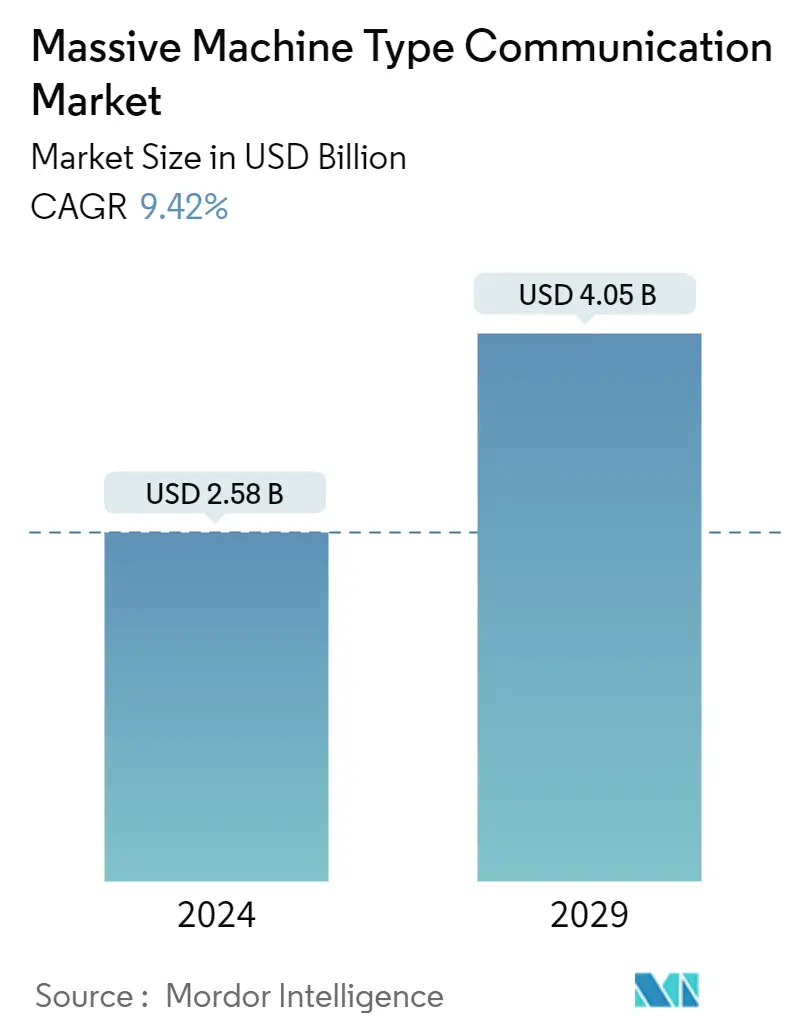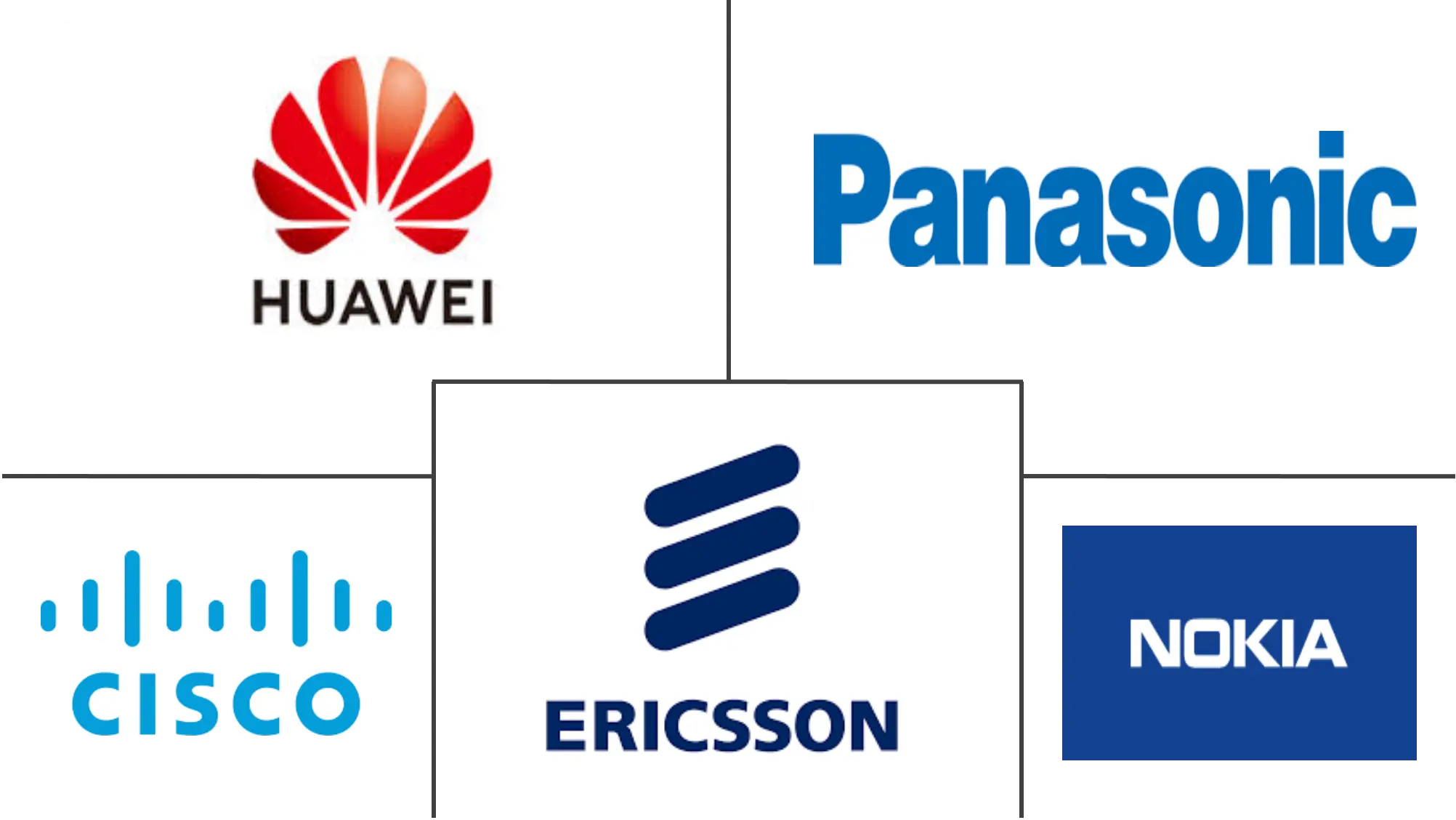| Study Period | 2019 - 2029 |
| Market Size (2024) | USD 2.58 Billion |
| Market Size (2029) | USD 4.05 Billion |
| CAGR (2024 - 2029) | 9.42 % |
| Fastest Growing Market | North America |
| Largest Market | Asia Pacific |
| Market Concentration | Medium |
Major Players*Disclaimer: Major Players sorted in no particular order |
Massive Machine Type Communication (MMTC) Market Analysis
The Massive Machine Type Communication Market size is estimated at USD 2.58 billion in 2024, and is expected to reach USD 4.05 billion by 2029, growing at a CAGR of 9.42% during the forecast period (2024-2029).
Machine-type communication (MTC) is a fundamental technology to realize the concept of a fully connected world in the fifth-generation (5G) Internet of Things (IoT).
- The development of the massive machine-type communication (MMTC) industry is being fueled by several key factors, such as the rising demand for fully automated processes, connected devices, wireless connectivity, rising investment in smart city projects, and investment and development in next-generation mobile network infrastructure. Smart cities are expanding globally as a result of urbanization, which is fueling market growth. According to UN forecasts, 404 million urban people in India, 212 million in Nigeria, and 292 million in China will be added to the current population by 2050.
- By 2023, the Japanese multinational holding corporation SoftBank planned to install 11,210 5G base stations. In addition, growing funding for smart city initiatives in this region, such as Asia-Pacific, contributes significantly to the expansion of mMTC implementation. The foundation of the smart city is massive machine-type communication, which permits machine-to-machine communication without requiring human input.
- Future 5G networks will likely be based on the heterogeneity of devices, technologies, and architectures, including IoT, UAVs, cloud and edge computing, etc. There would be a massive roll-out of IoT/MTCDs; these devices' simultaneous and unpredictable access will cause congestion and overload in 5G and beyond networks.
- However, the proliferation of MTC devices (MTCDs) propels serious challenges to the current cellular networks due to their huge number, particularly in ultra-dense scenarios like stadiums, concerts, hotspots, and flash crowds.
- The COVID-19 pandemic harmed the world economy. Lockdowns at the national level and social segregation standards in several nations severely impacted several businesses, including the mMTC sector. Since it was unclear how long the lockdowns would last, many 5G technology suppliers were under pressure, making it challenging for the major industry participants to predict when the mMTC market would recover.
Massive Machine Type Communication (MMTC) Industry Segmentation
Massive machine type communication (MTC), also known as massive machine communication (MMC) or massive Machine to Machine communication, is a type of communication between machines over wired or wireless networks where data generation, information exchange, and actuation occur with minimal or no human intervention.
The massive machine type communication market is segmented by communication channel type (wired, wireless), wnd-user industry (healthcare, transportation & logistics, utilities, energy, and other end-user industries (agriculture, industrial)), and geography (North America, Europe, Asia Pacific, Latin America, and Middle East and Africa). The market sizes and forecasts are provided in terms of value (USD) for all the above segments.
| Wired |
| Wireless |
| Healthcare |
| Transporation & Logistics |
| Utilities |
| Energy |
| Other End-users (Agriculture, Industrial) |
| North America |
| Europe |
| Asia Pacific |
| Rest of the World |
Massive Machine Type Communication Market Size Summary
The Massive Machine Type Communication (MMTC) market is poised for significant growth, driven by the increasing demand for fully automated processes and connected devices within the framework of the fifth-generation (5G) Internet of Things (IoT). This technology is essential for realizing a fully connected world, particularly in the context of smart cities, which are expanding rapidly due to urbanization. The market's expansion is further supported by investments in next-generation mobile network infrastructure and smart city projects, particularly in regions like Asia-Pacific. However, the proliferation of machine-type communication devices presents challenges to existing cellular networks, especially in ultra-dense scenarios such as stadiums and concerts. The COVID-19 pandemic temporarily disrupted the market, but recovery is anticipated as demand for 5G technology and infrastructure continues to grow.
In North America, the MMTC market is experiencing robust growth due to the high demand for faster connectivity and improved internet experiences. Significant investments in mobile network infrastructure and government spending on healthcare and smart city initiatives are driving market expansion in the region. The market is semi-consolidated, with major players like Huawei, Ericsson, Nokia, Cisco, and Panasonic actively engaging in partnerships and acquisitions to enhance their offerings. Recent collaborations, such as Fibocom's partnership with Sony Semiconductor Israel and Nokia's collaboration with NTT, highlight the industry's focus on advancing 5G technologies and Industry 4.0 applications. These developments, along with strategic investments and government support, are expected to sustain the market's growth trajectory over the forecast period.
Massive Machine Type Communication Market Size - Table of Contents
1. MARKET DYNAMICS
-
1.1 Market Drivers
- 1.1.1 Augmented Demand for A Better Connectivity Experience
- 1.1.2 Necessity for Fast Internet Connectivity
- 1.1.3 Requirement of 5G in IoT
-
1.2 Market Restraints
- 1.2.1 Technology Limitations to Support Constant High-Speed Connections
- 1.2.2 Large Investment Involved in Developing 5G Infrastructure
2. MARKET SEGMENTATION
-
2.1 By Communication Channel Type
- 2.1.1 Wired
- 2.1.2 Wireless
-
2.2 By End-user Industry
- 2.2.1 Healthcare
- 2.2.2 Transporation & Logistics
- 2.2.3 Utilities
- 2.2.4 Energy
- 2.2.5 Other End-users (Agriculture, Industrial)
-
2.3 By Geography
- 2.3.1 North America
- 2.3.2 Europe
- 2.3.3 Asia Pacific
- 2.3.4 Rest of the World
Massive Machine Type Communication (MMTC) Market Research FAQs
How big is the Massive Machine Type Communication Market?
The Massive Machine Type Communication Market size is expected to reach USD 2.82 billion in 2025 and grow at a CAGR of 9.42% to reach USD 4.43 billion by 2030.
What is the current Massive Machine Type Communication Market size?
In 2025, the Massive Machine Type Communication Market size is expected to reach USD 2.82 billion.




